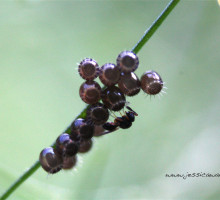
When someone hears the name stink bug, the likely reaction is a crunched up nose, a furrowed brow, and the utterance of the phrase “ewwww”. Having been subjected to the stench of these creatures on any number of occasions, I don’t blame them. With the majority of the 250 species of stink bugs in North America being plant-eating pests (and some of them serious ones at that), it’s easy to see why they have such a stinky reputation. The subfamily Asopinae, however, consists only of predatory species. These are the good guy stink bugs. All stink bugs stink. Even the beneficial species emit a distinct odor when handled or threatened. It is a defense mechanism—and a good one at that. Predaceous members of the stink bug family are known to consume common garden pests like caterpillars, Japanese beetles, Mexican bean beetles, Colorado potato beetle, lygus bug nymphs, beetle larvae, bollworms, herbivorous stink bugs, and others. Probably the most common and important predaceous stink bug is the spined soldier bug. The grayish brown adults have pointed shoulders with sharp points protruding from them. The rounded, wingless nymphs are orange with black markings. Spined soldier bugs, and other predaceous stink bugs, feed by stabbing prey with a knife-like mouthpart and consuming the innards. Spined soldier bugs are large, 0.35-0.55 in. (9-14 mm) long, and feed primarily at night. In addition, there are
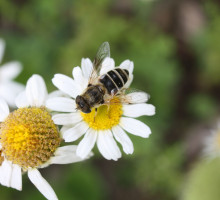
With nearly 900 species found across North America, syrphid flies (also called hover or flower flies) are a very important group of insects. The adults are frequently found hovering around flowers on bright, sunny days. Syrphid flies are significant pollinators, consuming nectar, pollen, and honeydew. As with all true flies, they have one pair of wings and, although at first glance some species may look superficially like small bees or wasps, their wing count is an easy way to separate the two (both bees and wasps have two pairs of wings). Syrphid flies can hover in mid-flight—hence their other common name of hover fly. They are often brightly colored with stripes or other markings. Many species mimic bees in their coloration with various patterns of black and yellow, white and black, and occasionally grey or brown. Adults measure between 0.16–1 in. (4–25 mm) with the majority of species falling somewhere in the middle and only a few at the extremes. While the adults feed on flower products, their larvae are busy chowing down on various soft-bodied insects, including aphids, thrips, leafhoppers, scales, caterpillars and others. Members of the subfamily Syrphinae all have predaceous larvae (called maggots—they are flies after all) that are legless and measure between 0.04–0.5 in. (1–13 mm) in length. They taper to a point at the head end and range in color from green to creamy white or
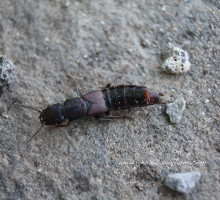
This interesting little guy is a member of the Rove beetle family (Staphylinidae). Though at first glance, he might look like an earwig, the two come from entirely different insect orders and are not related. The lack of cerci (enlarged, forecep-like pincers) on his hind-end is one easy way to tell the difference between an earwig and a rove beetle. The rove beetle family has the honor of being one of the largest family of beetles in North America with over 3,000 species.Worldwide, there are nearly 60,000 different species. A distinctive feature of most rove beetles are the short wing covers that leave their segmented abdomens exposed. When threatened, many species curl their abdomen upwards in a scorpion-like fashion. No need to worry, though, as these beetles have no stinger. They are generally brown to black in color and measure 0.08–0.78 in. (2–20 mm) in length, though some species can reach much larger. Rove beetles are very beneficial in the garden. They are predators of insects that feed on decaying organic matter (a handful of parasitic species exist as well). Rove beetles commonly consume bark beetles, slugs, snails, ants, termites, root maggots, and many other insects. Most often found in plant debris, in manure and compost piles, under stones and in woodlands, rove beetles are predaceous as both adults and larvae.. The fast-moving larvae feed on the same prey
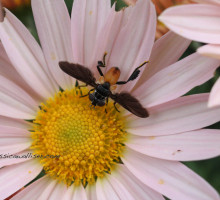
I found this beautiful fly sipping nectar from a perennial mum in my garden yesterday. A member of the tachinid fly family, Trichopoda pennipes (aka the feather-legged fly) is a very beneficial insect to have around. Tachinid flies are parasitoids that use many different insects as hosts for their developing young, and the feather-legged fly is no different. Female feather-legged flies lay tiny, pale-colored, oval eggs on true bugs, including squash bugs, stink bugs (!!!), and leaf-footed bugs. The eggs hatch, and the resulting larvae burrow down into the host insect and consume it as they develop through several instars, eventually bringing death to the host. Pupation takes place in the soil. Trichopoda pennipes produces two to three generations per year, and each female fly can lay several hundred eggs. Clearly, they are a valuable insect to have in the vegetable garden. Adult flies feed on pollen and nectar, particularly from members of the aster family. In my own garden, I frequently find them on my boltonia, black eyed Susans, coreopsis, yarrow, and asters. The feather-legged fly in this photo is a male, as evidenced by its orange abdomen (females have brown abdomens)
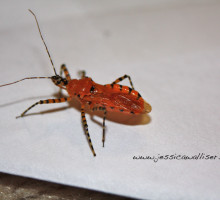
This beautiful orange creature is an assassin bug in the family Reduviidae. Pselliopsus barberi is one of over 100 species of assassin bugs in North America, and if there were a ninja of the insect world, this dude would be it. The aptly named assassin bug is sneaky, swift, vicious, and deadly. It uses a sharp, curved mouthpart (called a rostrum) to pierce insect prey and inject it with a lethal toxin before slurping up its innards. It might sound gross until you consider who this insect is having for lunch. Common prey include garden pests like hornworms, Mexican bean beetles, Colorado potato beetles, leafhoppers, aphids, caterpillars of all sorts, cucumber beetles, and many others. Adult assassin bugs can measure from 0.5–1.0 in. (13–25 mm) in length, depending on the species. Some species, like this one, are brightly colored, but most assassin bugs are brown, green, or black. They have broad bodies, elongated heads, and long, spindly legs. Females lay eggs on plants and the resulting nymphs (with their distinctive sway-backs) pass through several stages before fully maturing. Both adults and nymphs are covert little buggers and aren’t usually encountered by gardeners on a regular basis. At best, I come across one or two each season
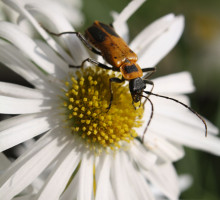
Soldier beetles, like this common Pennsylvania leatherwing, are an ubiquitous sight in my summer garden. There are some 470 different species of soldier beetles in North America and most are considered beneficial. As adults, all species have soft, leathery wings, fly well, and serve to pollinate various flowering plants. Larval soldier beetles live in leaf litter and under rocks, logs, and debris. Larvae feed primarily at night and are fast movers with large, grasping jaws that capture and consume insect eggs and prey, including grasshopper eggs, caterpillars, aphids, mealybugs and many others. Adults consume nectar, with many species also eating aphids and other insects. Both adult and larval soldier beetles can exude foul defensive chemicals to aid in their protection from other predators. In the western U.S., the brown leatherwing is a very common species.
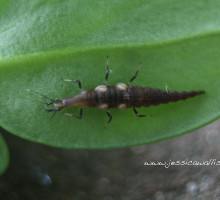
This crazy-looking creature is the larva of a brown lacewing (Micromus species). I found it hanging out on a lily leaf in my garden. Lacewing larvae use their curved mandibles to capture and consume soft-bodied insects like aphids, mealybugs, young caterpillars, beetle larvae, mites, and others. When mature, brown lacewings look much like their green cousins only slightly smaller and with brown coloration.
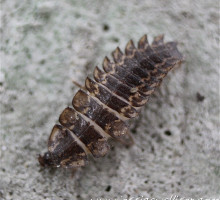
Fireflies are found on every continent except Antarctica, and there are about 150 different species of fireflies in North America. They are members of the Lampyridae family, and I found this beautiful larva on a driveway near a wetland in eastern Pennsylvania. Fireflies, also commonly called lightning bugs, use their bioluminescent abdomens to attract mates. The pattern of flashes is unique to each species, as is the color of their glow. Males fly around flashing a particular pattern in hopes of finding a female of the same species. He signals first then she signals her response, often from a low perch. Flash pattern charts can be used to distinguish many common species based on the number and duration of their flashes. In the eastern U.S., fireflies are a common summer sight, and while not all species glow as adults, they all do as larvae. Sometimes called glowworms in other parts of the world, larval fireflies, like this one, emit a steady, dull glow from their abdomens. Adult fireflies eat mostly pollen and nectar, though some species eat nothing at all. Female fireflies lay eggs in the ground (though a few tropical species lay eggs in trees). Favored egg laying sites include moist places near ponds and streams and in leaf litter. Larval fireflies live under or on the ground and serve as generalist predators, savoring slugs, snails, worms and other
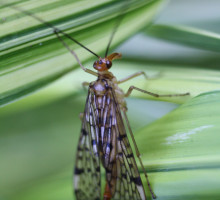
This beautiful creature is a scorpionfly in the genus Panorpa. I found her in my shade garden clinging to the golden grass. Scorpionflies are named as such because the males have an enlarged abdomen that curls upwards in a scorpion-like fashion. At the tip of the abdomen are two prongs used for mating. Though they may look scary, scorpionflies are incapable of stinging or biting. The elongated, snout-like mouthpart of the female in this picture is a distinctive feature of all scorpionflies. These insects are primarily scavengers, consuming dead or injured insects as well as occasionally preying on healthy ones and eating pollen and nectar. There are about 550 species of scorpionflies, and they are found across the U.S., though they are more common in the south. This is the first one I have ever found in my Pennsylvania garden
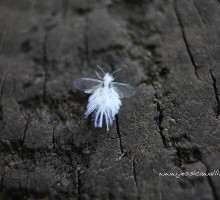
This delicate little creature is a woolly aphid in the subfamily Eriosomatinae (a Greek name that translates as “wool” + “body”). Often called “fairy flies”, these aphid-relatives are covered in white, waxy filaments that help camouflage them from predators and allow them to catch the wind and drift from primary to secondary host plants. Though many species of woolly aphid exist, one common species is the woolly apple aphid, a native of North America that uses apples and hawthorns as hosts. I found this fluffy little lady floating through a playground with a handful of her sisters. She graciously sat still for a few minutes so I could snap about a dozen images of her. Such a pretty little thing!